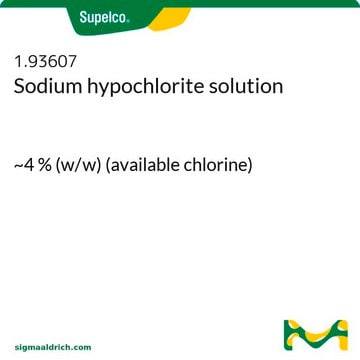Products may be shipped at a different temperature than the recommended long-term storage temperature. If the product quality is sensitive to short-term exposure to conditions other than the recommended long-term storage, it will be shipped on wet or dry-ice. If the product quality is NOT affected by short-term exposure to conditions other than the recommended long-term storage, it will be shipped at ambient temperature. As shipping routes are configured for minimum transit times, shipping at ambient temperature helps control shipping costs for our customers. For more information, please refer to the Storage and Transport Conditions document: https://www.sigmaaldrich.com/deepweb/assets/sigmaaldrich/marketing/global/documents/316/622/storage-transport-conditions-mk.pdf
239305
Sodium hypochlorite solution
reagent grade, available chlorine 4.00-4.99 %
About This Item
Recommended Products
grade
reagent grade
Quality Level
Agency
suitable for SM 4500 - NH3
vapor pressure
17.5 mmHg ( 20 °C)
form
liquid
composition
available chlorine, 4.00-4.99%
reaction suitability
reagent type: oxidant
concentration
4.00-4.99% (chlorine by Na2S2O3, titration)
density
1.097 g/mL at 25 °C
storage temp.
2-8°C
SMILES string
[Na+].[O-]Cl
InChI
1S/ClO.Na/c1-2;/q-1;+1
InChI key
SUKJFIGYRHOWBL-UHFFFAOYSA-N
Looking for similar products? Visit Product Comparison Guide
General description
Application
- Primary alcohols to aldehydes or carboxylic acids and secondary alcohols to ketones.
- Aryl aldehydes to the corresponding acids in the presence of a phase-transfer catalyst.
- Ethers to esters by careful pH control (pH range of 8–9.5),
It can also be used as a reagent in the:
- Epoxidation of enones and polycyclic arenes.
- Oxidative degradation reaction
- N-Chlorination of primary and secondary amines
- Enantioselective epoxidation of α, β-unsaturated ketones
- Asymmetric dihydroxylation of olefins in the presence of an osmium catalyst
- Chlorination of allylic carbons in the presence of CeCl3
Features and Benefits
- Readily available reagent
- Easily handled oxidizing agent
- No phase-transfer catalyst is necessary for the oxidation of substrates in the pH range 10–11
- Simplified waste disposal and lower toxicity
Disclaimer
Signal Word
Danger
Hazard Statements
Precautionary Statements
Hazard Classifications
Aquatic Acute 1 - Aquatic Chronic 2 - Eye Dam. 1 - Skin Irrit. 2
Storage Class Code
12 - Non Combustible Liquids
WGK
WGK 2
Flash Point(F)
Not applicable
Flash Point(C)
Not applicable
Choose from one of the most recent versions:
Certificates of Analysis (COA)
Don't see the Right Version?
If you require a particular version, you can look up a specific certificate by the Lot or Batch number.
Already Own This Product?
Find documentation for the products that you have recently purchased in the Document Library.
Customers Also Viewed
Related Content
This page is intended to make it easier to find the consumables you need based on the analytical method you’re using. Methods included on this page come from the EPA, Standard Methods and ASTM.
This page is intended to make it easier to find the consumables you need based on the analytical method you’re using. Methods included on this page come from the EPA, Standard Methods and ASTM.
This page is intended to make it easier to find the consumables you need based on the analytical method you’re using. Methods included on this page come from the EPA, Standard Methods and ASTM.
This page is intended to make it easier to find the consumables you need based on the analytical method you’re using. Methods included on this page come from the EPA, Standard Methods and ASTM.
-
How is shipping temperature determined? And how is it related to the product storage temperature?
1 answer-
Helpful?
-
-
How can I determine the shelf life / expiration / retest date of this product?
1 answer-
If this product has an expiration or retest date, it will be shown on the Certificate of Analysis (COA, CofA). If there is no retest or expiration date listed on the product's COA, we do not have suitable stability data to determine a shelf life. For these products, the only date on the COA will be the release date; a retest, expiration, or use-by-date will not be displayed.
For all products, we recommend handling per defined conditions as printed in our product literature and website product descriptions. We recommend that products should be routinely inspected by customers to ensure they perform as expected.
For products without retest or expiration dates, our standard warranty of 1 year from the date of shipment is applicable.
For more information, please refer to the Product Dating Information document: https://www.sigmaaldrich.com/deepweb/assets/sigmaaldrich/marketing/global/documents/449/386/product-dating-information-mk.pdfHelpful?
-
-
Is this HPLC Grade NaOCl?
1 answer-
This product is not HPLC grade. Unfortunately, an HPLC tested product is not available at this time.
Helpful?
-
-
Why does this have to be refrigerated?
1 answer-
While many commercially available products may be stored at room temperature, storing refrigerated helps to preserve the long-term shelf life of this material.
Helpful?
-
Active Filters
Our team of scientists has experience in all areas of research including Life Science, Material Science, Chemical Synthesis, Chromatography, Analytical and many others.
Contact Technical Service







